System Verilog Tutorial - VHDL
- 1. System Verilog tutorial E2MATRIX RESEARCH LAB OPP PHAGWARA BUS STAND, BACKSIDE AXIS BANK, PARMAR COMPLEX PHAGWARA, PUNJAB ( INDIA ). CONTACT : +91 9041262727 WEB : WWW.E2MATRIX.COM EMAIL : [email protected] 1
- 2. Overview Simulation and Synthesis Modules and Primitives Styles Structural Descriptions Language Conventions Data Types Delay Behavioral Constructs Compiler Directives Simulation and Testbenches 2
- 3. Simulation and Synthesis Simulation tools typically accept full set of Verilog language constructs Some language constructs and their use in a Verilog description make simulation efficient and are ignored by synthesis tools Synthesis tools typically accept only a subset of the full Verilog language constructs In this presentation, Verilog language constructs not supported in Synopsys FPGA Express are in red italics There are other restrictions not detailed here, see [2]. 3
- 4. Modules The Module Concept Basic design unit Modules are: Declared Instantiated Modules declarations cannot be nested 4
- 5. Module Declaration 5 Annotated Example /* module_keyword module_identifier (list of ports) */ module C_2_4_decoder_with_enable (A, E_n, D) ; input [1:0] A ; // input_declaration input E_n ; // input_declaration output [3:0] D ; // output_declaration assign D = {4{~E_n}} & ((A == 2'b00) ? 4'b0001 : (A == 2'b01) ? 4'b0010 : (A == 2'b10) ? 4'b0100 : (A == 2'b11) ? 4'b1000 : 4'bxxxx) ; // continuous_assign endmodule
- 6. Module Declaration 6 Identifiers - must not be keywords! Ports • First example of signals • Scalar: e. g., E_n • Vector: e. g., A[1:0], A[0:1], D[3:0], and D[0:3] Range is MSB to LSB Can refer to partial ranges - D[2:1] • Type: defined by keywords input output inout (bi-directional)
- 7. Module Instantiation 7 module C_4_16_decoder_with_enable (A, E_n, D) ; input [3:0] A ; input E_n ; output [15:0] D ; wire [3:0] S; wire [3:0] S_n; C_2_4_decoder_with_enable DE (A[3:2], E_n, S); not N0 (S_n, S); C_2_4_decoder_with_enable D0 (A[1:0], S_n[0], D[3:0]); C_2_4_decoder_with_enable D1 (A[1:0], S_n[1], D[7:4]); C_2_4_decoder_with_enable D2 (A[1:0], S_n[2], D[11:8]); C_2_4_decoder_with_enable D3 (A[1:0], S_n[3], D[15:12]); endmodule Example
- 8. Module Instantiation 8 • Single module instantiation for five module instances C_2_4_decoder_with_enable DE (A[3:2], E_n, S), D0 (A[1:0], S_n[0], D[3:0]), D1 (A[1:0], S_n[1], D[7:4]), D2 (A[1:0], S_n[2], D[11:8]), D3 (A[1:0], S_n[3], D[15:12]); • Named_port connection C_2_4_decoder_with_enable DE (.E_n (E_n), .A (A[3:2]) .D (S)); // Note order in list no longer important (E_n and A interchanged). More Examples
- 9. Primitives Gate Level and, nand or, nor xor, xnor buf , not bufif0, bufif1, notif0, notif1 (three-state) Switch Level *mos where * is n, p, c, rn, rp, rc; pullup, pulldown; *tran+ where * is (null), r and + (null), if0, if1 with both * and + not (null) 9
- 10. Primitives No declaration; can only be instantiated All output ports appear in list before any input ports Optional drive strength, delay, name of instance Example: and N25 (Z, A, B, C); //instance name Example: and #10 (Z, A, B, X); // delay (X, C, D, E); //delay /*Usually better to provide instance name for debugging.*/ Example: or N30 (SET, Q1, AB, N5), N41(N25, ABC, R1); Example: and #10 N33(Z, A, B, X); // name + delay 10
- 11. Styles Structural - instantiation of primitives and modules RTL/Dataflow - continuous assignments Behavioral - procedural assignments 11
- 12. Style Example - Structural module half_add (X, Y, S, C); input X, Y ; output S, C ; xor (S, X, Y) ; and (C, X, Y) ; endmodule 12 module full_add (A, B, CI, S, CO) ; input A, B, CI ; output S, CO ; wire N1, N2, N3; half_add HA1 (A, B, N1, N2), HA2 (N1, CI, S, N3); or P1 (CO, N3, N2); endmodule
- 13. Style Example - RTL/Dataflow 13 module fa_rtl (A, B, CI, S, CO) ; input A, B, CI ; output S, CO ; assign S = A ^ B ^ CI; //continuous assignment assign CO = A & B | A & CI | B & CI; //continuous assignment endmodule
- 14. Style Example - Behavioral 14 module fa_bhv (A, B, CI, S, CO) ; input A, B, CI ; output S, CO ; reg S, CO; // required to “hold” values between events. always@(A or B or CI) //; begin S <= A ^ B ^ CI; // procedural assignment CO <= A & B | A & CI | B & CI;// procedural assignment end endmodule
- 15. Connections By position association module C_2_4_decoder_with_enable (A, E_n, D); C_4_16_decoder_with_enable DX (X[3:2], W_n, word); A = X[3:2], E_n = W_n, D = word By name association module C_2_4_decoder_with_enable (A, E_n, D); C_2_4_decoder_with_enable DX (.E_n(W_n), .A(X[3:2]), .D(word)); A = X[3:2], E_n = W_n, D = word 16
- 16. Connections Empty Port Connections module C_2_4_decoder_with_enable (A, E_n, D); C_2_4_decoder_with_enable DX (X[3:2], , word); Input E_n is at high-impedance state (z) C_2_4_decoder_with_enable DX (X[3:2], W_n ,); Output D[3:0] unused. 17
- 17. Arrays of Instances { , } is concatenate Example module add_array (A, B, CIN, S, COUT) ; input [7:0] A, B ; input CIN ; output [7:0] S ; output COUT ; wire [7:1] carry; full_add FA[7:0] (A,B,{carry, CIN},S,{COUT, carry}); // instantiates eight full_add modules endmodule 18
- 18. Language Conventions Case-sensitivity Verilog is case-sensitive. Some simulators are case-insensitive Advice: - Don’t use case-sensitive feature! Keywords are lower case Different names must be used for different items within the same scope Identifier alphabet: Upper and lower case alphabeticals decimal digits underscore 19
- 19. Language Conventions Maximum of 1024 characters in identifier First character not a digit Statement terminated by ; Free format within statement except for within quotes Strings enclosed in double quotes and must be on a single line Comments: All characters after // in a line are treated as a comment Multi-line comments begin with /* and end with */ Compiler directives begin with // synopsys Built-in system tasks or functions begin with $ 20
- 20. Logic Values 21 Verilog signal values 0 - Logical 0 or FALSE 1 - Logical 1 or TRUE x, X - Unknown logic value z, Z - High impedance condition Also may have associated signal and charge strengths for switch level modeling of MOS devices 7 signal strengths plus 3 charge strengths
- 21. Number Representation Format: <size><base_format><number> <size> - decimal specification of number of bits default is unsized and machine-dependent, but at least 32 bits <base format> - ' followed by arithmetic base of number <d> <D> - decimal - default base if no <base_format> given <h> <H> - hexadecimal <o> <O> - octal <b> <B> - binary <number> - value given in base of <base_format> _ can be used for reading clarity If first character of sized, binary number is 0, 1, the value is 0-filled up to size. If x or z,value is extended using x or z, respectively. 22
- 22. Number Representation Examples: 6’b010_111 gives 010111 8'b0110 gives 00000110 8’b1110 gives 00001110 4'bx01 gives xx01 16'H3ABgives 0000001110101011 24 gives 0…0011000 5'O36 gives 11100 16'Hx gives xxxxxxxxxxxxxxxx 8'hz gives zzzzzzzz 23
- 23. Variables Nets Used for structural connectivity Registers Abstraction of storage (May or may not be real physical storage) Properties of Both Informally called signals May be either scalar (one bit) or vector (multiple bits) 24
- 24. Data Types - Nets - Semantics 25 wire - connectivity only; no logical tri - same as wire, but indicates will be 3- stated in hardware wand - multiple drivers - wired and wor - multiple drivers - wired or triand - same as wand, but 3-state trior - same as wor but 3-state supply0 - Global net GND supply1 - Global Net VCC (VDD) tri0, tri1, trireg
- 25. Net Examples wire x; wire x, y; wire [15:0] data, address; wire vectored [1:7] control; wire address = offset + index; wor interrupt_1, interrupt_2; tri [31:0] data_bus, operand_bus; Value implicitly assigned by connection to primitive or module output 26
- 26. Initial Value & Undeclared Nets Initial value of a net At tsim = 0, initial value is x. Undeclared Nets - Default type Not explicitly declared default to wire default_nettype compiler directive can specify others except for supply0 and supply1 27
- 27. Data Types - Register Semantics reg - stores a logic value integer – stores values which are not to be stored in hardware Defaults to simulation computer register length or 32 bits whichever is larger No ranges or arrays supported May yield excess hardware if value needs to be stored in hardware; in such a case, use sized reg. time - stores time 64-bit unsigned real - stores values as real num realtime - stores time values as real numbers 28
- 28. Register Assignment A register may be assigned value only within: a procedural statement a user-defined sequential primitive a task, or a function. A reg object may never by assigned value by: a primitive gate output or a continuous assignment 29
- 29. Register Examples reg a, b, c; reg [15:0] counter, shift_reg; reg [8:4] flops; integer sum, difference; 30
- 30. Strings No explicit data type Must be stored in reg whose size is 8*(num. of characters) reg [255:0] buffer; //stores 32 characters 31
- 31. Constants (Paramters) Declaration of parameters parameter A = 2’b00, B = 2’b01, C = 2’b10; parameter regsize = 8; reg [regsize - 1:0]; /* illustrates use of parameter regsize */ 32
- 32. Operators Arithmetic (binary: +, -,*,/,%*); (unary: +, -) Bitwise (~, &,|,^,~^,^~) Reduction (&,~&,|,~|,^,~^,^~) Logical (!,&&,||,==,!=,===,!==) Relational (<,<=,>,>=) Shift (>>,<<) Conditional ? : Concatenation and Replications {A,B} {4{B}} * Not supported for variables 33
- 33. Expression Bit Widths Depends on: widths of operands and types of operators Verilog fills in smaller-width operands by using zero extension. Final or intermediate result width may increase expression width 34
- 34. Expression Bit Widths Unsized constant number- same as integer (usually 32 bits) Sized constant number - as specified x op y where op is +, -, *, /, %, &, |, ^, ^~: Arithmetic binary and bitwise Bit width = max (width(x), width(y)) 35
- 35. Expression Bit Widths (continued) op x where op is +, - Arithmetic unary Bit width = width(x) op x where op is ~ Bitwise negation Bit width = width(x) 36
- 36. Expression Bit Widths (continued) x op y where op is ==, !==, ===, !===, &&, ||, >, >=, <, <= or op y where op is !, &, |, ^, ~&, ~|, ~^ Logical, relational and reduction Bit width = 1 x op y where op is <<, >> Shift Bit width = width(x) 37
- 37. Expression Bit Widths (continued) x ? y : z Conditional Bit width = max(width(y), width(z)) {x, …, y} Concatenation Bit width = width(x) + … + width(y) {x{y, …, z}} Replication Bit width = x * (width(y) + … + width(z)) 38
- 38. Expressions with Operands Containing x or z Arithmetic If any bit is x or z, result is all x’s. Divide by 0 produces all x’s. Relational If any bit is x or z, result is x. Logical == and != If any bit is x or z, result is x. === and !== All bits including x and z values must match for equality 39
- 39. Expressions with Operands Containing x or z Bitwise Defined by tables for 0, 1, x, z operands. Reduction Defined by tables as for bitwise operators. Shifts z changed to x. Vacated positions zero filled. Conditional If conditional expression is ambiguous (e.g., x or z), both expressions are evaluated and bitwise combined as follows: f(1,1) = 1, f(0,0) = 0, otherwise x. 40
- 40. Simulation Time Scales Compiler Directive `timescale <time_unit> / <time_precision> time_unit - the time multiplier for time values time_precision - minimum step size during simulation - determines rounding of numerical values Allowed unit/precision values: {1| 10 | 100, s | ms | us | ns | ps} 41
- 41. Simulation Time Scales (continued) Example: `timescale 10ps / 1ps nor #3.57 (z, x1, x2); nor delay used = 3.57 x 10 ps = 35.7 ps => 36 ps Different timescales can be used for different sequences of modules The smallest time precision determines the precision of the simulation. 42
- 42. Behavioral Constructs Concurrent communicating behaviors => processes same as behaviors Two constructs initial - one-time sequential activity flow - not synthesizable but good for testbenches Always - cyclic (repetitive) sequential activity flow Use procedural statements that assign only register variables (with one exception) 43
- 43. Behavioral Constructs (continued) Continuous assignments and primitives assign outputs whenever there are events on the inputs Behaviors assign values when an assignment statement in the activity flow executes. Input events on the RHS do not initiate activity - control must be passed to the statement. 44
- 44. Behavioral Constructs (continued) Body may consist of a single statement or a block statement A block statement begins with begin and ends with end Statements within a block statement execute sequentially Behaviors are an elaborate form of continuous assignments or primitives but operate on registers (with one exception) rather than nets 45
- 45. Behavioral Constructs - Example Initial: Always: initial always begin begin one = 1; F1 = 0, F2 = 0; two = one + 1; # 2 F1 = 1; three = two + 1; # 4 F2 = 0; four = three + 1; # 2 F1 = 1; five = four + 1; # 4; end end What are results of each of the above? 46
- 46. Procedural Assignments Types = blocking assignment assign = continuous assignment <= non-blocking assignment Assignments (with one exception) to: reg integer real realtime time 47
- 47. Procedural Assignments - Some Rules Register variable can be referenced anywhere in module Register variable can be assigned only with procedural statement, task or function Register variable cannot be input or inout Net variable can be referenced anywhere in module Net variable may not be assigned within behavior, task or function. Exception: force … release Net variable within a module must be driven by primitive, continuous assignment, force … release or module port 48
- 48. Procedural Timing, Controls & Synchronization Mechanisms Delay Control Operator (#) Event Control Operator (@)* Event or Named Events – not used much wait construct 49 *Ignored by FPGA express unless a synchronous trigger that infers a register
- 49. Procedural Timing, Controls & Synchronization Delay Control Operator (#) Precedes assignment statement - postpones execution of statement For blocking assignment (=), delays all statements that follow it Blocking assignment statement must execute before subsequent statements can execute. Example: always @(posedge clk), #10 Q = D; 50
- 50. Procedural Timing, Controls & Synchronization Event Control Operator (@)* Synchronizes the activity flow of a behavior to an event (change) in a register or net variable or expression Example 1: @ (start) RegA = Data; Example 2: @(toggle) begin … @ (posedge clk) Q = D; … end *Ignored by FPGA express unless a synchronous trigger that infers a register 51
- 51. Procedural Timing, Controls & Synchronization Event or - allows formation of event expression Example: always @ (X1 or X2 or X3) assign Y = X1 & X2 | ~ X3; All RHS variables in sensitivity list and no unspecified conditional results => combinational logic 52
- 52. Procedural Timing, Controls & Synchronization Meaning of posedge: 0 -> 1, 0 -> x, x -> 1 Special Example: always @ (set or reset or posedge clk) begin if (reset == 1) Q = 0; else if (set == 1) Q = 1; else if (clk == 1) Q = data; end // Does this work correctly? Why or why not? 53
- 53. Procedural Timing, Controls & Synchronization (FIO) wait Construct Suspends activity in behavior until expression following wait is TRUE Example: always begin a = b; c = d; wait (advance); end 54
- 54. Blocking Assignments Identified by = Sequence of blocking assignments executes sequentially Example: always @(posedge clk) begin b = 0; c = 0; b = a + a; c = b + a; d = c + a; end 55
- 55. Non-Blocking Assignments Identified by <= Sequence of non-blocking assignments executes concurrently Example 1: always @(posedge clk) begin b <= 0; c <= 0; b <= a + a; c <= b + a; d <= c + a; end /*Calculates b = 2a, c = b + a, d <= c + a. All values used on RHS are those at posedge clock. Note that there are two assignments to b and c. Only the last one is effective. */ 56
- 56. Blocking Assignments - Inter- Assignment Delay Delays evaluation of RHS and assignment to LHS Example: always @(posedge clk) begin b = 0; c = 0; b = a + a; // uses a at posedge clock #5 c = b + a; // uses a at posedge clock + 5 d = c + a; // uses a at posedge clock + 5 end /*c = 2 a(at posedge clock)+ a(at posedge clock + 5) d = 2 a(at posedge clock) + 2 a(at posedge clock + 5)*/ 57
- 57. 58 Delays assignment to LHS and subsequent statements, not evaluation of RHS Example: always @(posedge clk) begin b = 0; c = 0; b = a + a; // uses a at posedge clock c = #5 b + a; // uses a at posedge clock d = c + a; // uses a at posedge clock + 5 end /* c = 3 a(at posedge clock) d = 3a (at posedge clock)+ a (at posedge clock + 5)*/ Blocking Assignment - Intra-Assignment Delay
- 58. Non-Blocking Assignment - Inter- Assignment Delay Delays evaluation of RHS and assignment to LHS Delays subsequent statements Example: always @(posedge clk) begin b <= 0; c <= 0; b <= a + a; // uses a at posedge clock #5 c <= b + a; // uses b and a at posedge clock + 5 d <= c + a; // uses a at posedge clock + 5 end /*c = b(at posedge clock + 5) + a(at posedge clock + 5) d = c(at posedge clock + 5) + a (at posedge clock +5) */ 59
- 59. Non-Blocking Assignment - Intra- Assignment Delay Delays only assignment to LHS Example: always @(posedge clk) begin b <= 0; c <= 0; b <= a + a; // uses a at posedge clock c <= #5 b + a; // uses a and b at posedge clock d <= c + a; // uses a and c at posedge clock end /* Calculates *c(posedge clock + 5) = b(at posedge clock) + a(at posedge clock); d(posedge clock) = c(at posedge clock) + a (at posedge clock) */ 60
- 60. Activity Control 61 Overview Constructs for Activity Control • Conditional operator • case statement • if … else statement • Loops : repeat, for, while, forever • disable statement • fork … join statement Tasks and Functions
- 61. Conditional Operator ? … : Same as for use in continuous assignment statement for net types except applied to register types Example: always@(posedge clock) Q <= S ? A : B //combined DFF and 2-to-1 MUX 62
- 62. case Statement Requires complete bitwise match over all four values so expression and case item expression must have same bit length Example: always@(state, x) begin reg[1:0] state; case (state) 2’b00: next_state <= s1; 2’b01: next_state <= s2; 2’b10: if x next_state <= s0; else next_state <= s1; end default next_state = 1’bxx; endcase end 63
- 63. casex Statement Requires bitwise match over all but positions containing x or z; executes first match encountered if multiple matches. Example: always@(code) begin casex (code) 2’b0x: control <= 8’b00100110; //same for 2’b0z 2’b10: control <= 8’b11000010; 2’b11: control <= 8’b00111101; default control <= 8b’xxxxxxxx; endcase end 64
- 64. casez Statement Requires bitwise match over all but positions containing z or ? (? is explicit don’t care); executes first match encountered if multiple matches. Example: reg [1:0] code; always@(code) begin casez (code) 2’b0z: control <= 8’b00100110; 2’b1?: control <= 8’b11000010; default control <= 8b’xxxxxxxx; endcase end 65
- 65. Conditional (if … else) Statement Example always@(a or b or c) begin if (a == b) begin q <= data; stop <= 1’b1; end else if (a > b) q <= a; else q <= b; end end end 66
- 66. Conditional (if … else) Statement (continued) Must be careful to define outcome for all possible conditions – failure do do so can cause unintentional inference of latches! else is paired with nearest if when ambiguous - use begin and end in nesting to clarify. Nested if … else will generate a “serial” or priority like circuit in synthesis which may have a very long delay - better to use case statements to get “parallel” circuit. 67
- 67. for Loop Example Example: initial integer r, i; begin r = 0; for (i = 1; i <= 7; i = i + 2) begin r[i] = 1; end end 68
- 68. while Loop Example initial begin r = 0; i = 0; while (i <= 7) begin r[i] = 1; i = i + 2; end end 69
- 69. forever Loop Example initial begin clk = 0; forever begin #50 clk = 1; #50 clk = 0; end end Usually used in testbenches rather than for synthesized logic. 70
- 70. Tasks Declared within a module Referenced only by a behavior within the module Parameters passed to task as inputs and inouts and from task as outputs or inouts Local variables can be declared Recursion not supported although nesting permitted (nested copies of variables use same storage) See Fig. 7.43 p. 226 of [5]for rules 71
- 71. Task Example task leading_1; input [7:0] data_word; output [2:0] position; reg [7:0] temp; reg [2:0] position; begin temp = data_word; position = 3'b111; while (!temp[7]) @(posedge clock) begin temp = temp << 1; position = position - 1; end end endtask // Code is not synthesizable 72
- 72. Functions Implement combinational behavior No timing controls or tasks which implies no while May call other functions with no recursion Reference in an expression, e.g. RHS No output or inout allowed Implicit register having name and range of function 73
- 73. Function Example function [2:0] leading_1; input [7:0] data_word; reg [7:0] temp; begin temp = data_word; leading_1 = 3'b111; while (!temp[7]) begin temp = temp << 1; leading_1 = leading_1 - 1; end end endfunction Is the above code synthesizable? 74 No
- 74. Compiler Directives Useful for controlling what is synthesized and the resulting logic Warning: Not recognized by other compilers – therefore reduce code portability Examples: // synopsys translate_off Code here describes something that is not to be synthesized such at a simulation testbench - can contain non-synthesizable constructs such as delays) // synopsys translate_on 75
- 75. Compiler Directives (Continued) Examples: // synopsys parallel_case Forces generation of multiplexer-like structure instead of priority structure when included after case declaration // synopsys full_case Indicates that all cases have been considered when included in case declaration; when used, no default statement needed and latches will not be inferred can be used in combination with parallel case: case (state) // synopsys parallel_case full_case 76
- 76. Testbench Approach Use Verilog module to produce testing environment including stimulus generation and/or response monitoring 77 UUT Module Stimulus Response Testbench Module
- 77. Stimulus Generation Example `timescale 1ns /1ns module com_test_bench_v; reg[8:0] stim; wire[3:0] S; wire C4; adder_4_b_v a1(stim[8:5], stim[4:1], stim[0], S, C4); //Continued on next slide endmodule 78
- 78. Stimulus Generation Example (Continued) //Generate stimulus initial begin stim = 9'b000000000; #10 stim = 9'b111100001; #10 stim = 9'b000011111; #10 stim = 9'b111100010; #10 stim = 9'b000111110; #10 stim = 9'b111100000; #10 stim = 9'b000011110; #10 $stop; end 79



![Simulation and Synthesis
Simulation tools typically accept full set of Verilog
language constructs
Some language constructs and their use in a Verilog
description make simulation efficient and are ignored
by synthesis tools
Synthesis tools typically accept only a subset of the
full Verilog language constructs
In this presentation, Verilog language constructs not
supported in Synopsys FPGA Express are in red italics
There are other restrictions not detailed here, see [2].
3](https://image.slidesharecdn.com/sys-veri-151225074104/85/System-Verilog-Tutorial-VHDL-3-320.jpg)
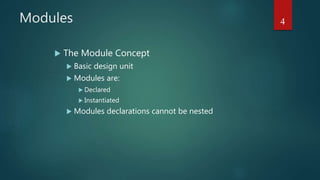
![Module Declaration
5
Annotated Example
/* module_keyword module_identifier (list of ports) */
module C_2_4_decoder_with_enable (A, E_n, D) ;
input [1:0] A ; // input_declaration
input E_n ; // input_declaration
output [3:0] D ; // output_declaration
assign D = {4{~E_n}} & ((A == 2'b00) ? 4'b0001 :
(A == 2'b01) ? 4'b0010 :
(A == 2'b10) ? 4'b0100 :
(A == 2'b11) ? 4'b1000 :
4'bxxxx) ; // continuous_assign
endmodule](https://image.slidesharecdn.com/sys-veri-151225074104/85/System-Verilog-Tutorial-VHDL-5-320.jpg)
![Module Declaration
6
Identifiers - must not be keywords!
Ports
• First example of signals
• Scalar: e. g., E_n
• Vector: e. g., A[1:0], A[0:1], D[3:0], and D[0:3]
Range is MSB to LSB
Can refer to partial ranges - D[2:1]
• Type: defined by keywords
input
output
inout (bi-directional)](https://image.slidesharecdn.com/sys-veri-151225074104/85/System-Verilog-Tutorial-VHDL-6-320.jpg)
![Module Instantiation
7
module C_4_16_decoder_with_enable (A, E_n, D) ;
input [3:0] A ;
input E_n ;
output [15:0] D ;
wire [3:0] S;
wire [3:0] S_n;
C_2_4_decoder_with_enable DE (A[3:2], E_n, S);
not N0 (S_n, S);
C_2_4_decoder_with_enable D0 (A[1:0], S_n[0], D[3:0]);
C_2_4_decoder_with_enable D1 (A[1:0], S_n[1], D[7:4]);
C_2_4_decoder_with_enable D2 (A[1:0], S_n[2], D[11:8]);
C_2_4_decoder_with_enable D3 (A[1:0], S_n[3], D[15:12]);
endmodule
Example](https://image.slidesharecdn.com/sys-veri-151225074104/85/System-Verilog-Tutorial-VHDL-7-320.jpg)
![Module Instantiation
8
• Single module instantiation for five module instances
C_2_4_decoder_with_enable DE (A[3:2], E_n, S),
D0 (A[1:0], S_n[0], D[3:0]),
D1 (A[1:0], S_n[1], D[7:4]),
D2 (A[1:0], S_n[2], D[11:8]),
D3 (A[1:0], S_n[3], D[15:12]);
• Named_port connection
C_2_4_decoder_with_enable DE (.E_n (E_n), .A (A[3:2]) .D (S));
// Note order in list no longer important (E_n and A interchanged).
More Examples](https://image.slidesharecdn.com/sys-veri-151225074104/85/System-Verilog-Tutorial-VHDL-8-320.jpg)






![Connections
By position association
module C_2_4_decoder_with_enable (A, E_n, D);
C_4_16_decoder_with_enable DX (X[3:2], W_n, word);
A = X[3:2], E_n = W_n, D = word
By name association
module C_2_4_decoder_with_enable (A, E_n, D);
C_2_4_decoder_with_enable DX (.E_n(W_n), .A(X[3:2]),
.D(word));
A = X[3:2], E_n = W_n, D = word
16](https://image.slidesharecdn.com/sys-veri-151225074104/85/System-Verilog-Tutorial-VHDL-15-320.jpg)
![Connections
Empty Port Connections
module C_2_4_decoder_with_enable (A, E_n, D);
C_2_4_decoder_with_enable DX (X[3:2], , word);
Input E_n is at high-impedance state (z)
C_2_4_decoder_with_enable DX (X[3:2], W_n ,);
Output D[3:0] unused.
17](https://image.slidesharecdn.com/sys-veri-151225074104/85/System-Verilog-Tutorial-VHDL-16-320.jpg)
![Arrays of Instances
{ , } is concatenate
Example
module add_array (A, B, CIN, S, COUT) ;
input [7:0] A, B ;
input CIN ;
output [7:0] S ;
output COUT ;
wire [7:1] carry;
full_add FA[7:0] (A,B,{carry, CIN},S,{COUT, carry});
// instantiates eight full_add modules
endmodule
18](https://image.slidesharecdn.com/sys-veri-151225074104/85/System-Verilog-Tutorial-VHDL-17-320.jpg)







![Net Examples
wire x;
wire x, y;
wire [15:0] data, address;
wire vectored [1:7] control;
wire address = offset + index;
wor interrupt_1, interrupt_2;
tri [31:0] data_bus, operand_bus;
Value implicitly assigned by connection to primitive
or module output
26](https://image.slidesharecdn.com/sys-veri-151225074104/85/System-Verilog-Tutorial-VHDL-25-320.jpg)


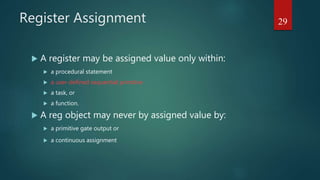
![Register Examples
reg a, b, c;
reg [15:0] counter, shift_reg;
reg [8:4] flops;
integer sum, difference;
30](https://image.slidesharecdn.com/sys-veri-151225074104/85/System-Verilog-Tutorial-VHDL-29-320.jpg)
![Strings
No explicit data type
Must be stored in reg whose size is 8*(num. of characters)
reg [255:0] buffer; //stores 32 characters
31](https://image.slidesharecdn.com/sys-veri-151225074104/85/System-Verilog-Tutorial-VHDL-30-320.jpg)
![Constants (Paramters)
Declaration of parameters
parameter A = 2’b00, B = 2’b01, C = 2’b10;
parameter regsize = 8;
reg [regsize - 1:0]; /* illustrates use of parameter regsize */
32](https://image.slidesharecdn.com/sys-veri-151225074104/85/System-Verilog-Tutorial-VHDL-31-320.jpg)







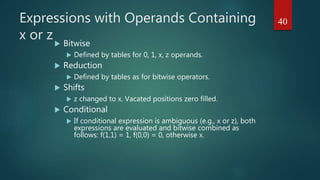
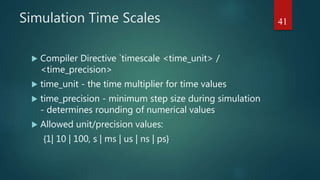


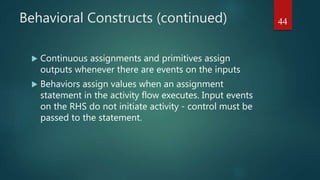


















![case Statement
Requires complete bitwise match over all four values so
expression and case item expression must have same bit
length
Example: always@(state, x) begin
reg[1:0] state;
case (state)
2’b00: next_state <= s1;
2’b01: next_state <= s2;
2’b10: if x next_state <= s0;
else next_state <= s1;
end
default next_state = 1’bxx;
endcase
end
63](https://image.slidesharecdn.com/sys-veri-151225074104/85/System-Verilog-Tutorial-VHDL-62-320.jpg)

![casez Statement
Requires bitwise match over all but positions containing
z or ? (? is explicit don’t care); executes first match
encountered if multiple matches.
Example:
reg [1:0] code;
always@(code) begin
casez (code)
2’b0z: control <= 8’b00100110;
2’b1?: control <= 8’b11000010;
default control <= 8b’xxxxxxxx;
endcase
end
65](https://image.slidesharecdn.com/sys-veri-151225074104/85/System-Verilog-Tutorial-VHDL-64-320.jpg)


![for Loop Example
Example:
initial
integer r, i;
begin
r = 0;
for (i = 1; i <= 7; i = i + 2)
begin
r[i] = 1;
end
end
68](https://image.slidesharecdn.com/sys-veri-151225074104/85/System-Verilog-Tutorial-VHDL-67-320.jpg)
![while Loop Example
initial
begin
r = 0;
i = 0;
while (i <= 7)
begin
r[i] = 1;
i = i + 2;
end
end
69](https://image.slidesharecdn.com/sys-veri-151225074104/85/System-Verilog-Tutorial-VHDL-68-320.jpg)

![Tasks
Declared within a module
Referenced only by a behavior within the module
Parameters passed to task as inputs and inouts and
from task as outputs or inouts
Local variables can be declared
Recursion not supported although nesting permitted
(nested copies of variables use same storage)
See Fig. 7.43 p. 226 of [5]for rules
71](https://image.slidesharecdn.com/sys-veri-151225074104/85/System-Verilog-Tutorial-VHDL-70-320.jpg)
![Task Example
task leading_1;
input [7:0] data_word;
output [2:0] position;
reg [7:0] temp;
reg [2:0] position;
begin
temp = data_word;
position = 3'b111;
while (!temp[7])
@(posedge clock)
begin
temp = temp << 1;
position = position - 1;
end
end
endtask // Code is not synthesizable
72](https://image.slidesharecdn.com/sys-veri-151225074104/85/System-Verilog-Tutorial-VHDL-71-320.jpg)
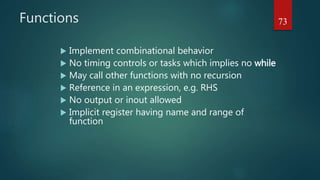
![Function Example
function [2:0] leading_1;
input [7:0] data_word;
reg [7:0] temp;
begin
temp = data_word;
leading_1 = 3'b111;
while (!temp[7])
begin
temp = temp << 1;
leading_1 = leading_1 - 1;
end
end
endfunction
Is the above code synthesizable?
74
No](https://image.slidesharecdn.com/sys-veri-151225074104/85/System-Verilog-Tutorial-VHDL-73-320.jpg)



![Stimulus Generation Example
`timescale 1ns /1ns
module com_test_bench_v;
reg[8:0] stim;
wire[3:0] S;
wire C4;
adder_4_b_v a1(stim[8:5], stim[4:1], stim[0], S, C4);
//Continued on next slide
endmodule
78](https://image.slidesharecdn.com/sys-veri-151225074104/85/System-Verilog-Tutorial-VHDL-77-320.jpg)
